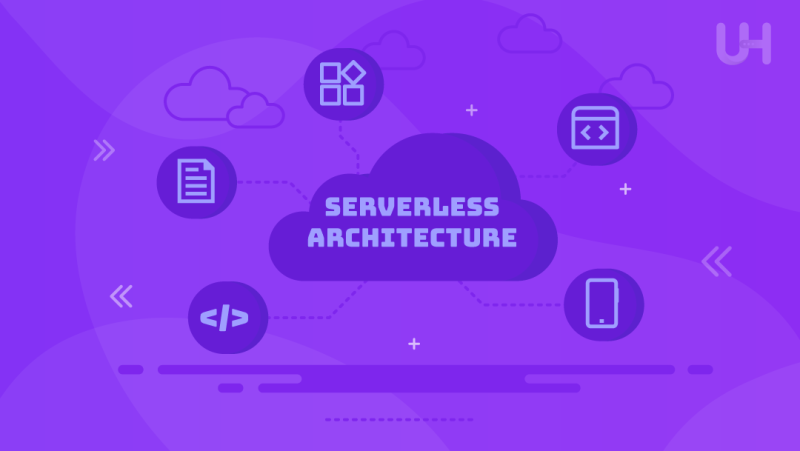Serverless architecture has been lately recognized as a breakthrough in developing and deploying cloud-based software applications. This disruptive paradigm profoundly changes how developers think, build, and manage software systems. Serverless computing abstracts away any infrastructure concerns, encouraging developers to focus on writing application logic. This speeds up the development process and adds flexibility to software deployment.
In this article, we will delve into what serverless architecture entails, benefits of serverless architecture, and the drawbacks it presents compared to traditional hosting.
What is Serverless Architecture?
Serverless architecture is purposely created to take most of the infrastructure management responsibility away from developers. This enables dynamic management of server allocation and provisioning. Unlike traditional server setups, developers under a serverless model no longer have to worry about leasing or purchasing server capacity upfront. There is no necessity to worry about server maintenance and scaling with serverless computing.
The term “serverless” is false because it suggests no servers exist. Quite the contrary, servers are equally important in this architecture, but their management is abstracted away from a developer’s gaze. That aspect of idea is, in essence, a core guiding principle for serverless computing. All developers have to do is write and deploy the code; things such as server maintenance, resource allocation, and, of course, resilience in infrastructure are the business of service providers like the cloud. This makes development easier and more efficient because developers can focus on their core product without the overhead of server management.
Pros of Serverless Architecture
Here are the key benefits of serverless architecture:
Cost Efficiency
One of the primary advantages of serverless architecture is its cost efficiency. With serverless computing, organizations only pay for the resources their applications actually use. This pay-as-you-go model can significantly reduce the overhead and operational costs associated with idle servers and unused capacity.
Scalability
Serverless applications are inherently scalable and can automatically adjust to meet the varying demands of the application. Whether small requests have to be processed or thousands are to be processed in parallel, the serverless framework will adaptively scale resources for the articulate performance of the application. Respective actions are taken without any manual developer interventions, giving highly elastic solutions to adapt to different patterns of workloads. Such elasticity is especially useful in applications with erratic traffic, making serverless the ideal platform to cater to sporadic or explosive growth in demand.
Faster Time-to-Market
The absence of infrastructure management in serverless computing allows developers to devote their full attention to coding, significantly reducing administrative burdens. This streamlining of processes accelerates development cycles, leading to faster deployments and a quicker time-to-market. Such agility is invaluable for businesses, enabling them to swiftly adapt and respond to rapid market changes, thereby maintaining a competitive edge.
Simplified Operational Management
Serverless computing abstracts the complexities of servers and infrastructure management, hence shifting the onus of routines of maintenance, patching, and the like to cloud providers. This changes operational demands and reduces the level of infrastructure expertise developers require. With serverless computing, handing off such responsibilities allows the teams to focus more on development and innovation rather than getting weighed down by the technicalities of server upkeep.
Improved Reliability
Serverless platforms enhance the robustness and reliability of applications by automatically managing both the physical hardware and virtualized resources an application needs to run on. The built-in fault tolerance and high-availability features of these platforms prevent, therefore, the chances of application downtime and can potentially result in a more reliable and predictable user experience. The automatic tuning of critical resource settings helps maintain control of the service under dynamic or unpredictable loads.
Seamless SSL for Serverless Architecture!
Looking for reliable SSL certificates? Choose UltaHost for unbeatable security and seamless integration with your serverless architecture. Secure your applications with confidence today!
Cons of Serverless Architecture
Here are the cons of serverless architecture:
Vendor Lock-In
Serverless services introduce businesses into a significant lock-in with the features of their chosen cloud provider. This high dependency is because serverless applications are usually heavily integrated with the special tools and services of that particular provider. This creates infeasibility in provider transition, as it will bear massive application changes. The result is that this may severely limit a company’s flexibility and sovereignty over its infrastructure.
Cold Starts
The “cold start” issue is the most customary challenge with serverless computing. The problem arises when the function is not called or has not been used for some time, in which case the provider has to start a completely new instance of the arrangement of the function’s runtime environment every time it is called. This incurs startup time, which can degrade performance in applications where a quick response is essential. Thereby disrupting the ideal of rapid execution that serverless deployments aim to provide.
Debugging and Monitoring Challenges
Traditional debugging and monitoring techniques have complexities in a serverless architecture. As developers have no direct control over backend servers, it is hard for them to find and fix problems. Hence, it needs tools and services provided by the cloud for diagnoses designed explicitly for serverless environments. In many cases, a re-architecture of existing systems is also required to fully leverage these tools and optimize performance. So, these cloud-provided tools and services can bring paradigm shifts in traditional techniques for managing application performance and troubleshooting. Often, this can have a steeper learning curve and vendor lock-in for the users.
Security Concerns
Although cloud providers offer good security measures, serverless applications can be open to security risks from shared resources. Besides, the distributed nature of serverless complicates the management of application security, as applications will interact with several services and APIs that may not be 100% security-compliant. In addition, the assurance of data privacy becomes a challenge because sensitive information will traverse multiple systems and environments, making it more prone to exposure in the case of a breach.
Limitations on Local Development
Developing serverless applications and testing them locally can be a headache because they greatly depend on the cloud environment. Developers often have to use emulation software or deploy code directly to the cloud for testing. This is most of the time the case. Such processes can complicate development in different ways. For instance, emulation may not perfectly mirror the cloud environment. Additionally, frequent cloud deployments can be time-consuming and expensive at times.
Comparison with Traditional Hosting Options
The comparison of serverless architecture with traditional hosting options depends on several factors.
- Managed VPS: A serverless architecture can scale much better and more cost-effectively than a managed VPS hosting, which usually involves provisioning and maintaining virtual servers manually. However, a managed VPS might provide more control over infrastructure and better performance for applications with a consistent workload.
- Dedicated Hosting: While dedicated hosting servers offers complete control over physical servers, it lacks the scalability and cost benefits of serverless architecture. Serverless is more suited to applications with variable workloads and agile development requirements.
- Fast VPS: This speeds up the performance and speed to be a top consideration for fast VPS solutions. On another note, however, fast VPS hosting solutions may not be as scalable and cost-efficient as serverless architecture. Additionally, serverless eliminates concerns over server resource management, enabling developers to focus on coding without adjusting server configurations.
Conclusion
Serverless architecture has the benefits of cost-saving, scalability, operational simplicity, and faster time-to-market. However, it also faces problems such as vendor lock-in, cold start performance, and monitoring and security complexities. An organization must weigh such pros and cons and determine if serverless computing aligns with its needs and capabilities. As this technology matures, one can expect some improvements that will make serverless architecture more compelling to many more classes of applications.
Considering a migration to serverless architecture? Ultahost provides expert solutions for seamless website migration, ensuring a smooth transition to harness the benefits of serverless computing. Explore Ultahost today for your serverless journey.
FAQ
How does serverless architecture save costs?
Pay-as-you-go model, no idle server costs.
What are the scalability benefits of serverless architecture?
Automatic scaling based on demand.
How does serverless architecture improve time-to-market?
Faster deployments, no infrastructure management.
What are cold starts in serverless computing?
Delays when functions run after being idle.
Can serverless architecture lead to vendor lock-in?
Yes, due to dependency on specific cloud service








